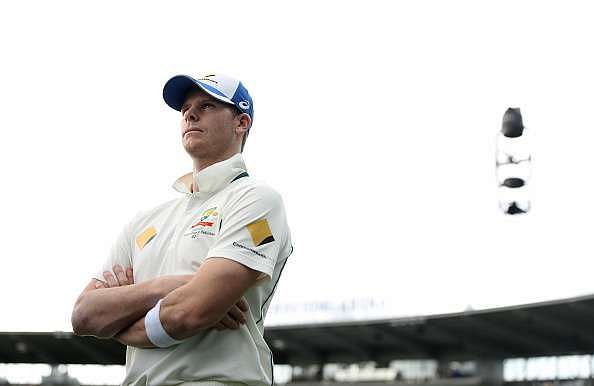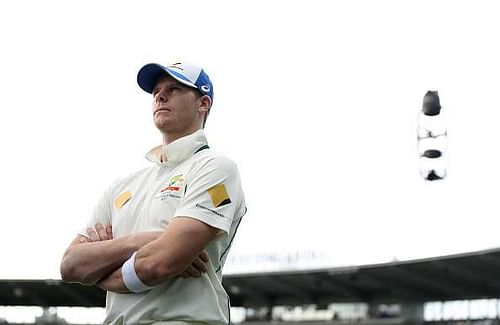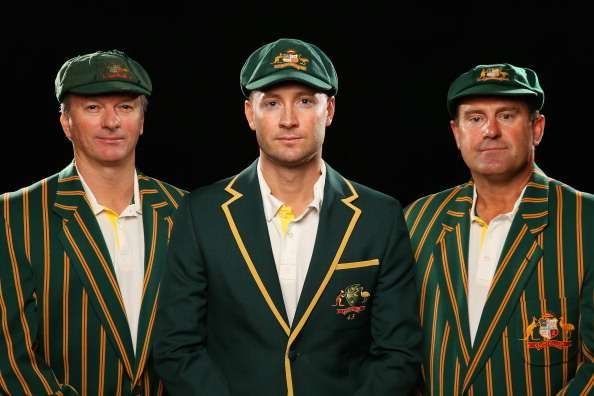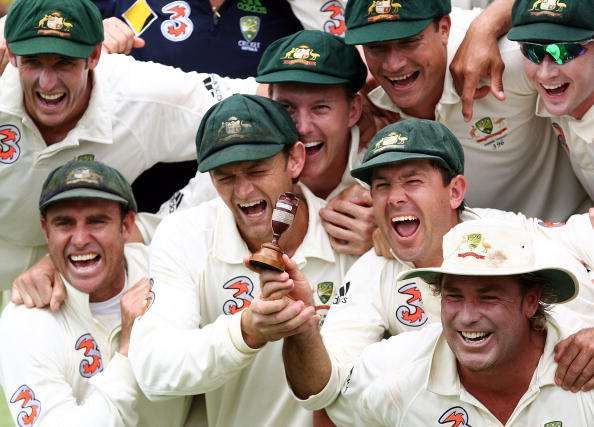
Is this the worst Australian team in three decades?

What makes a team bad? Is it the defeats? Is it the way they go down without even a semblance of a fight? Is it the way they cow down at the first sign of pressure? Is it the way they show rank vulnerability against a particular set of conditions, say, fast bowling or turning tracks or green tops?
Australia is touching a nadir at the moment as far as its cricketing standards are concerned. The last time they hit such a low was when they were walloped 1-3 at home in the 2010/11 Ashes series by England. They managed, thanks to Darren Lehmann and his relaxed approach to cricket, to come back sharply and smartly.
Then, the reason was obvious – the exodus of several of their greats – and excusable. But, half a decade hence, Australia have hit a strange low that has sneaked upon them from nowhere as a culmination of several wrongs that they never fixed. In two months, across two subcontinents, Australia have been made to look pedestrian and that is what would hurt a proud and often conceited side.
Already there are questions around whether the present Australia side is the worst in three decades. That the sides from the 90s and 2000s were way better than the present one is much too obvious. However, in terms of poor performances, the present team is at par with the one in the 80s, one of the worst Australian sides ever, before Allan Border and then, Mark Taylor rebuilt the team.
Win-Loss ratios
The decade of 1980-1989 was a particularly bad one for Australia as they won only 27 and lost 31, with 38 draws, having played 97 matches. Their W/L ratio was 0.870 and their batting average was at a real low, 33.98. However, the big dip in their W/L ratio was largely due to their subjugation by one team, West Indies.
Australia had lost 11 Tests to West Indies in the 1980s, winning just 3, out of a total of 19 Tests. They were 11-9 against England in 32 Tests and 4-6 against Pakistan in 17 Tests.
Between 1990-1999, Australia played 108 matches, won 54 and lost 25, ending 29 in a draw, with a W/L ratio of 2.160 and a batting average of 35. In the 90s, Australia didn’t lose more matches than it won against any team, the worst W/L being against West Indies, 9-9. They were 16-5 against England, dominating their rivals completely and 5-3 against South Africa, as the latter had just gained re-entry into international cricket.
Between 2000-2009, Australia won 79 of their 115 Tests, losing just 18 and ending another 18 in a draw. That made up for an astronomical W/L ratio of 4.388. The batting average was a phenomenal 43.07 and the run-rate was an impressive 3.66.
In that decade, Australia lost only one series at home – to South Africa in 2008-09. Also, Australia were head and shoulders ahead of every team except India. They were 7-7 against India, in terms of wins and losses. The next lowest W/L ratio was against England, 15-6. Against South Africa, Australia were 13-4.
They lost just one Test to West Indies, winning 15 and hadn’t lost a single Test to New Zealand, Pakistan, Bangladesh, Zimbabwe or Sri Lanka.
Between 2010-2016, Australia have lost more matches already than it did in the previous 10 years. Out of the 76 matches played Australia has won 37 and lost 27 matches, ending 12 in a draw for a W/L record of 1.370. The batting average has dropped to 36.21.
Interestingly, Australia’s saving grace has been their 7 wins against New Zealand as compared to a lone defeat and their 6 wins against West Indies without losing a single one. Australia is neck to neck with India (6-6), Pakistan (3-3) and England (8-9). Against South Africa, they have won 3 and lost 5.
Home record

In the 1980s, Australia’s home record was marred by one team – West Indies, who won 8 and lost only 3. Apart from that, Australia had a W/L ratio greater than 1 against every team. They were 5-3 against England, 4-2 against New Zealand, 1-1 against India, 2-0 against Sri Lanka and 4-1 against Pakistan, in the games where there was a result.
In the 1990s Australia’s home record improved drastically, as they won 34 Tests at home and lost just 8. Against West Indies, they were 4-4. Pakistan managed to beat them once and so did South Africa. England managed to beat them twice, although England lost 9 times during that decade.
Also Read: Australia’s last 5 series defeats at home
In the 2000s, Australia became virtually impregnable for every team. Only India, South Africa and England managed to defeat them at home. India had the best record, winning 2 and losing 4 matches. South Africa won 2 and lost 6, both the victories coming in the same series. England won a game and lost 9. Australia were 10-0 against West Indies and 4-0 each against New Zealand and Pakistan.
However, Australia’s home record is taking a beating since 2010. Australia have lost 3 and won nothing against South Africa at home. They have lost 3 against England although they won 6. Even New Zealand have managed to beat them once having lost 3 games. One team that has boosted Australia’s numbers is India, which contrary to its impressive record down under until now, have lost 6 Tests and won nothing.
Away record
Australia in the 1980s had an abysmal record away from home. It was 0-5 in Pakistan and 0-3 in West Indies. Only against England, Australia were at par, winning 6 and losing 6. They won a match against New Zealand, having lost 2 and had a lone win against Sri Lanka. They were 0-0 against India.
In the 1990s, Australia did boost their away performance. They were 1-2 against New Zealand, 5-5 against West Indies, 1-1 against Sri Lanka, 7-3 against England (who were going through a bad patch and lost home Ashes frequently), 3-2 against South Africa (a team still finding its feet), 1-1 against Pakistan and 1-3 against India.
Also Read: Performance of teams in neutral venues in cricket
For the 2000s, India remained the final frontier for a very long time. Australian invincibles were 5-0 against New Zealand, 6-5 against England, 7-2 against South Africa, 3-0 against Pakistan, 5-1 against West Indies and 3-0 against Sri Lanka. Only against India did Australia lose more than they won with a 3-5 record.
The team of the 2010s have shown themselves as poor travellers. They are 0-6 in India, 1-3 versus Pakistan, 1-3 versus Sri Lanka and 2-6 against England. Australia’s away numbers look good largely because of their 4-0 record against a weak West Indian team, 4-0 against Trans-Tasman rivals New Zealand and a 3-2 record against South Africa.
Batting and bowling average home and away

In the 2010s, Australia average 31.81 with the bat away and in neutral venues. At home, they average 42.09 with the bat. With the ball, they have averaged 30.36 at home and 31.95 away.
In the 2000s, Australia have averaged 29.75 with the ball away from home and 28.35 at home. With the bat, however, they average a whopping 47.67 at home and an equally impressive 38.88 away which shows or rather demonstrates why their record, home and away is so good during that decade.
In the 1990s, Australia averaged 33.32 with the bat away from home and 30.28 with the ball. At home, their average with the bat was 37.27 while their average with the ball is 26.10 which is quite impressive. This was the time when they started to find their core bowling group that included Glenn McGrath and Shane Warne.
In the 1980s, Australia averaged 33.94 with the bat away from home while it averaged 36.34 with the ball. At home, they averaged 31.96 with the ball and 34.02 with the bat.
Conclusion
There are certain aspects of the current Australian team which are quite obvious from the statistics:
- They are poor travellers with an unimpressive away record.
- They look particularly bad because they are following up on great acts - a near-invincible run during the 2000s and an impressive decade in the 1990s.
- The current Australian team is definitely not worse than the teams of the 1980s who had a poorer W/L record.
- The current Australia team has poor averages away and at home, with bat and ball compared to the previous two decades. Most of the present stats are comparable though, with those of the 1980s.
- The present Australian team has lost more often to more teams than the teams of the past 3 decades which had only one or at most couple of arch-rivals – England in the 80s and 90s and India and South Africa in the 2000s.
It doesn’t help that Steve Smith’s men are largely inexperienced compared to the players or rather battalions commanded by Steve Waugh, Ricky Ponting and to a certain extent, Michael Clarke. While Waugh built his team, Ponting inherited it. Clarke had a couple of strong shoulders in players like Michael Hussey, something Smith doesn’t have.
That is what is hurting the present team the most, weakening the middle order and making the team extremely vulnerable under any conditions conducive to any form of bowling. Eventually, it is showing up in the results and while drastic changes are underway, the slide may not be arrested immediately.
Stats courtesy: Cricinfo